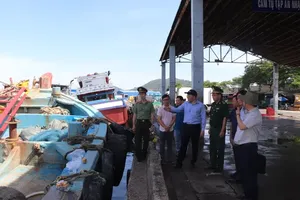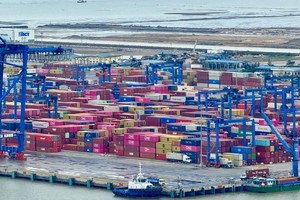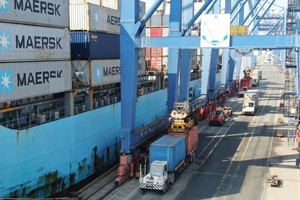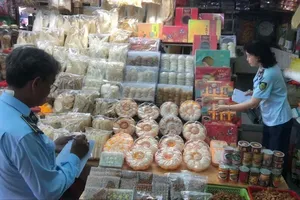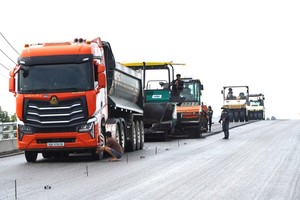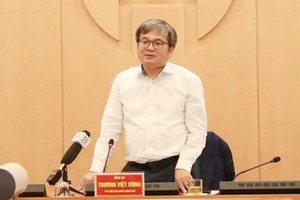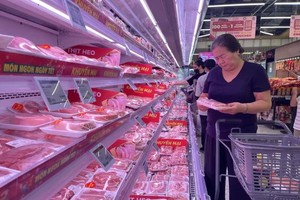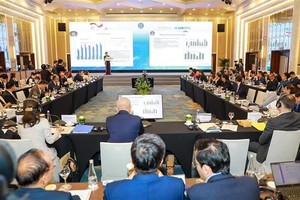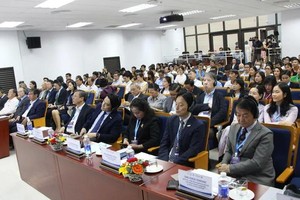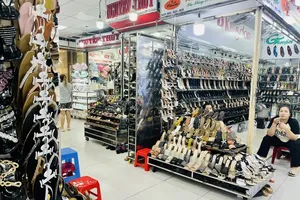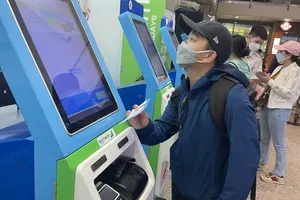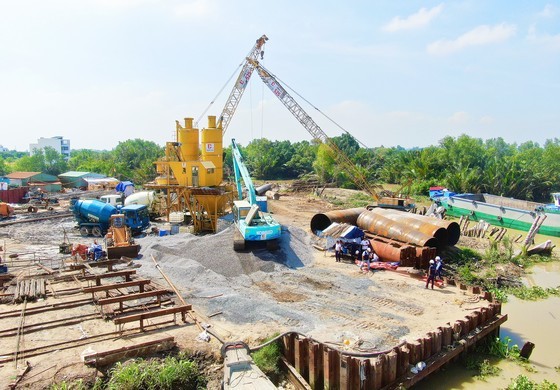 |
However, it only received VND306 trillion (less than $13 billion) from the National Assembly and the Government, merely meeting 66 percent of the demand. Therefore, it is very urgent to find and attract non-budget capital sources.
PPP projects in risk
According to the Ministry of Transport, in the 2011-2015 period, private capital mobilization reached more than VND186.66 trillion (nearly $8 billion), accounting for 42 percent of the total investment in transport infrastructure. In particular, the road sector attracted 58 projects with a total investment of VND158.07 trillion (nearly $6.7 billion), while the inland waterway sector attracted 1 project with a total investment of VND1,303 trillion ($55 million). For the maritime sector, in the 2011-2020 period, non-budget capital accounted for a large proportion, with more than VND173 trillion ($7.3 billion) coming from many leading corporations in the world. Evaluating the efficiency and process of investment implementation of BOT (build - operate - transfer) and BT (build - transfer) projects in recent years, Deputy Minister of Transport Mr. Le Dinh Tho said that the traffic projects invested with non-budget capital contributed to socio-economic development, reducing public debt pressure, and stimulating demand for domestic production. Many BOT projects promoted very good efficiency, saving time and travel costs.
However, from 2016 up to now, attracting social capital for transport infrastructure has been gradually reduced and increasingly difficult. This is partly because the investment model of BOT projects in the previous period revealed many shortcomings, hence no longer attractive. Many BOT projects put into operation have met with negative reactions from the residents. This has resulted in traffic flow reduction and sent investors to debt and the risk of bankruptcy. In addition, the lack of completeness and synchrony, as well as the incompatibility with reality and international norms of the legal documents regulating BOT investment also discourages many investors. Therefore, only 3 out of 23 component projects of the two Eastern North-South Expressway projects have been implemented under the public-private partnership (PPP) method. According to the Ministry of Transport, many expressway PPP projects were launched two to three years ago, such as Huu Nghi - Chi Lang, and Dong Dang - Tra Linh projects, but still face capital problems. The mobilization of social capital in the fields of railways, waterways, maritime, and aviation has not been fully implemented due to the lack of attractive mechanisms.
Promoting attraction of non-budget capital
To develop transport infrastructure in the coming period, according to leaders of the Ministry of Transport, attracting non-budget capital is mandatory. Particularly for roads, Director of the Vietnam Road Administration (Ministry of Transport) Nguyen Van Cuong said that the capital need for this period is about VND390 trillion ($16.5 billion), but only VND250 trillion ($10.5 billion) available from the central budget capital. The rest is to be mobilized from non-budget sources. In the aviation sector, according to Mr. Nguyen Anh Dung, Deputy Director of the Planning and Investment Department (Ministry of Transport), the demand for infrastructure investment capital in the 2021-2030 period only factors in 28 airports under planning. Accordingly, the Airports Corporation of Vietnam shall contribute the majority of the capital required, with other parts being shared by the Ministry of Transport and the rest in need to be mobilized.
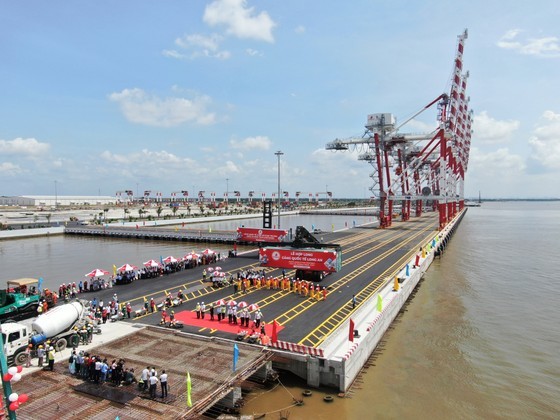 |
Long An International Port has merged seven berths and opened container handling services on June 24, 2023. |
Similarly, inland waterways, maritime, and railway sectors also need to mobilize more social resources. As for railways, according to the railway network master plan for the 2021-2030 period, with a vision to 2050 approved by the Prime Minister, the investment capital demand for national railway infrastructure development by 2030 is up to hundreds of thousands of billion VND for 9 new railway lines with a total length of 2,362km. A representative of the Ministry of Transport revealed that in the previous stage, the state budget for railway investment only accounted for 5.8 percent of the total demand. In the coming period, the budget allocated for railways will increase, but will mainly focus on the implementation of the North-South high-speed railway project and other projects, including the Ho Chi Minh City - Can Tho City railway project with a capital need of about $7 billion. According to Mr. Vu Quang Khoi, Director of the Vietnam Railway Administration (Ministry of Transport), the Law on Railways has a preferential mechanism to attract private investment in railways, but in reality, it cannot be implemented due to the requirement of high synchronization in locomotives, wagons, information, and signal systems, as well as high investment efficiency in railways, while its commercial advantages compared to investment in other fields are not high.
According to Minister of Transport Nguyen Van Thang, the Ministry of Transport is currently researching and proposing solutions to remove obstacles and promote the attraction of private investment in transport infrastructure under the PPP method. In particular, the Ministry of Transport will consider and adjust regulations accordingly, such as the risk-sharing mechanism, the transitional terms when changing policies, the revenue guarantee mechanism, and the foreign currency conversion guarantee. In the near future, the Ministry of Transport will organize a promotion conference to invite investors, listen to investors' opinions, and continue to advise on solving difficulties, especially those related to the mobilization of foreign investors to participate in the development of transport infrastructure.
Minister of Planning and Investment, Mr. Nguyen Chi Dung
Breakthrough to pay debt
When discussing a new draft resolution to replace Resolution 54 on piloting a number of specific mechanisms and policies for HCMC's development, it was suggested by members of the National Assembly that, in response to the need of a large resource, a policy should be built for the city to issue international bonds or borrow a loan of about $20-30 billion to radically solve all the infrastructure problems for the city. It will then only need a specific mechanism to make it right, focused and effective. When the city manages to rise above the troubles, and contributes back to the country, it can completely return that money, without affecting the economy indicators. Therefore, HCMC's proposal on being flexible in mobilizing capital from bonds will become NA members’ main interest and study focus to find out how it can be properly implemented.
Minister of Finance, Mr. Ho Duc Phoc:
Careful research in demand
Regarding the fact that HCMC wants to issue local government bonds to the international market to raise enough $16 billion to complete the urban railway network (metro), it is important to find investors to buy bonds. This is not easy because Vietnam has not issued international bonds for a long time. Therefore, it is necessary to research carefully, both on the international market and the provisions of the law. The issue of bonds also has to consider the issue of public debt and interest rate. Relevant sides should also factor in the interest rates, as the current rates for bonds issued by corporations are up to 10 to 11 percent.
Vice President of Ho Chi Minh City Road and Bridge Science Association, Mr. Ha Ngoc Truong
Beneficiaries are to pay
The investment in metro construction is very expensive, so in order to promote investment in the construction of urban infrastructure systems, the principle of recovering investment funds based on the view of "beneficiaries must pay" should be properly applied. Investment in urban railways brings added values of land and real estate in the region, so the Government needs to regulate these added values to continue investing for urban railways or other technical infrastructure works.



